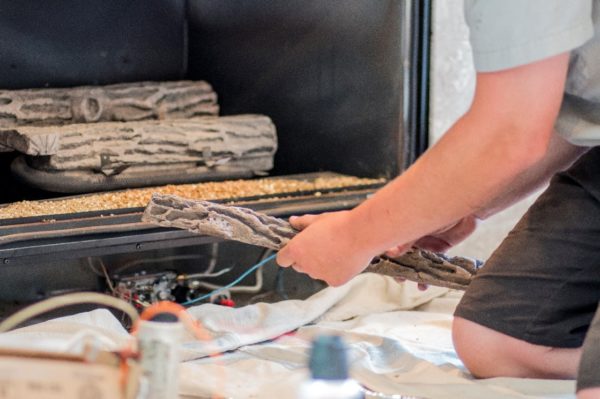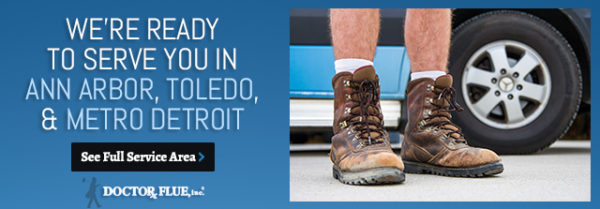
Fireplaces and chimneys are more complex than many homeowners believe. During your next chimney inspection, your chimney sweep may mention one or more chimney part names that you aren’t familiar with. Understanding your fireplace and chimney better can make it safer for you to use and maintain it over the years. In this article, we’ll concentrate on masonry and gas fireplaces, defining and explaining fireplace and chimney part names, and those parts only found in gas fireplaces.
Key Masonry Chimney Parts
The chimney is the structure which carries off the smoke and gasses of a fire. It extends upward from the fireplace and includes the part visibly seen above the rooftop. A masonry chimney and fireplace combination can weigh a ton…usually several tons! While you may think that because it is built of bricks or stone and mortar that it is indestructible, that isn’t the case. Chimneys are vulnerable to weather and water. Constant exposure to the freeze/thaw cycle can lead to deterioration and, if ignored too long, expensive repair.
Flue:
The flue is the name of the duct or passageway smoke and gasses travel up and exit through. When most people think “chimney” they are referring to the visible brick or stone exterior that houses the flue. Most often made of baked clay, flues can also be made of stainless steel.
Flue Lining:
The interior lining of a masonry chimney is the flue lining. The lining protects the chimney walls, and ultimately your home, from heat and corrosion. Linings can be composed of ceramic, metal or clay.
It's hard for a typical homeowner to identify damaged flue lining. When doing inspections on older homes, like those in the Bowling Green area, it's not uncommon to see that a fireplace has been used when it's posing a major fire risk!
Chimney Damper:
The chimney damper is a movable plate or door, generally made of cast iron or sheet metal, which, when closed, prevents cold air or downdrafts from moving down into the house when no fire is burning in the fireplace. Generally operated by a cable or lever, any homeowner who has ever forgotten to open the damper prior to starting a fire will also tell you that the damper allows the smoke to rise and escape!
Chimney Crown:
Sealing the top of the chimney and shedding water away from the flue are jobs performed by the chimney crown. The crown, sometimes known as the wash, should be sloped downward. This angled design directs rain, and snow as it melts, away from the chimney. A properly constructed chimney crown is key in preventing chimney erosion and leaks.
Chimney Cap:
One of the most inexpensive ways to prevent chimney damage is to install a chimney cap. A chimney cap, or rain cover, keeps water – and even animals – out of your chimney. Some models are designed to rotate, blocking wind gusts. They can be simple or decorative, but always worth the ounce of prevention against water damage.
Smoke Shelf:
The smoke shelf deflects downdrafts. It also prevents rain and soot from falling into the fireplace. It is located at the bottom of the smoke chamber which connects the flue and fireplace. In chimneys not equipped with a chimney cap, rain can pool on the smoke shelf and mix with soot. The resulting acidic mixture can eat away at mortar joints.
Key Masonry Fireplace Parts
Firebox:
Firebox is the formal name for the inside of the fireplace – the place you build the fire. Of course, the firebox, composed of firebrick, is designed take the heat of the fire, but water damage, poor construction or simply just years of expanding and contracting can take their toll and joints can fail. Regular inspections are recommended.
Hearth:
The hearth is the floor of the fireplace, providing a fireproof area on which to build a fire. Generally composed of brick, stone or cement, the hearth extends beyond the firebox into the room providing a layer of protection for your home’s floor. Historically, meals were cooked over the fire, so a hearth was large enough to accommodate cooking pots and utensils or even a bench to sit and keep warm. Modern hearths still protect the home from heat, sparks or flying embers, however many hearths are now constructed for visual appeal. Though the floor of the firebox is still constructed of fireproof materials, the part of the hearth that extends into the room may be made of granite, flagstone or marble. Gas fireplaces do not require a hearth unless it is a wood-burning fireplace that has been converted to gas.
Fireplace Doors:
Fireplace doors are designed to minimize the amount of air going up the chimney from the room, or an added protection against cold air entering the room when the fireplace is not in use. They also shut off the air flow when the fire has died down. Unlike the pyro-ceramic glass of woodstove doors, the tempered glass of fireplace doors is not intended to take the extreme heat produced when a fire is burning. Additionally, if the fireplace doors are closed while a roaring fire is burning, the volume of airflow is interrupted. This can cause the temperature inside the firebox and flue to become greatly elevated. If protection from flying sparks is desired a mesh screen or curtain is recommended. They keep the embers in the fireplace and let the heat pass through into your home. There are many combinations of fireplace doors and mesh screens or curtains to offer function and style for your fireplace.
Unique Parts of a Gas Fireplace
Gas fireplaces may not require a hearth, but glass-fronted appliances or those with glass doors are required to have a warning and protective barrier to reduce the risk of burns. Gas fireplaces have a few additional components that traditional wood fireplaces do not.
Thermocouple:
The thermocouple is a safety mechanism that measures heat. It is made of two different metals such as copper and iron. Taking advantage of an electrical effect that occurs at the junction between different metals, the thermocouple recognizes if a pilot light is out due to the lack of heat. Consequently, it shuts down the fuel supply which prevents a buildup of gas.
Thermopile:
A thermopile also detects and measures radiant energy (heat) and shuts down the fuel supply if the pilot light goes out, but it consists of a number of thermocouples joined together. Thermopiles are larger, generally measuring about 3/8” in diameter, due to the multiple thermocouples wired together inside. Keep in mind that whether your gas fireplace has a thermopile or thermocouple, regular maintenance is recommended. They work best when clean and don’t last forever.
Pilot Light:
A continuously burning light, the pilot light is used to light a larger burner when needed. That small, blue flame ignites the gas that is released when a furnace or fireplace is turned on. If the pilot light goes out, your fireplace will not light. The pilot light and thermocouple (or thermopile) work together to keep your home safe and your fireplace in working order. If you have to relight your pilot light and it won’t stay lit, there’s a good chance it’s time to replace your thermocouple.
Fireplaces, whether gas or wood burning, are cozy, long-lasting and add value to your home. With care and regular maintenance, they can provide a lifetime of enjoyment.
Now Is a Great Time for a Chimney Inspection – Contact Doctor Flue!
If you have questions about your fireplace or chimney, contact us today! We offer chimney services and products in Michigan and Ohio and can help you avoid common chimney risks so you can have peace of mind.
Call Us: 1-800-438-3583
Email Us: office@drflue.com
Office Hours: Mon-Fri: 8am-4pm
Connect with Doctor Flue on Social Media

